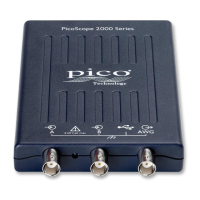PicoScope 2200A Series User's Guide 13
Copyright © 2013 Pico Technology Limited. All rights reserved. ps2200a.en r1
Streaming mode—A data collection mode in which the oscilloscope samples data and
returns it to the computer in a continuous stream. This mode allows the capture of
more data than will fit in the oscilloscope's memory buffer, at sampling rates over 1
MS/s (PC dependent). The PicoScope program selects this mode for long timebases to
enable the capture of very long sets of data.
Timebase—A timer that controls the speed at which the scope device captures data.
At slow timebases this process is visible as PicoScope draws the trace across the scope
view from left to right, but at fast timebases PicoScope draws the whole trace in a
single operation. The timebase is measured in units of time (such as seconds) per
division. There are ten divisions across the scope view, so the total time across the
width of the view is ten times the "per division" setting.
USB 1.1—An early version of the Universal Serial Bus standard found on older PCs.
Although your PicoScope will work with a USB 1.1 port, it will operate much more
slowly than with a USB 2.0 or 3.0 port.
USB 2.0—Universal Serial Bus (High Speed). A standard port used to connect external
devices to PCs. The high-speed data connection provided by a USB 2.0 port enables
your PicoScope to achieve its maximum performance.
USB 3.0—A faster version of the Universal Serial Bus standard. Your PicoScope is fully
compatible with USB 3.0 ports and will operate with the same performance as on a
USB 2.0 port.
Vertical resolution—A value, in bits, indicating the precision with which the
oscilloscope converts input voltages to digital values. PicoScope's Resolution
Enhancement function can improve the effective vertical resolution.
Voltage range—The range of input voltages that the oscilloscope can measure. For
example, a voltage range of ±100 mV means that the oscilloscope can measure
voltages between -100 mV and +100 mV. Input voltages outside this range will not be
measured correctly, but will not damage the instrument as long as they remain within
the protection limits stated in the specifications.

